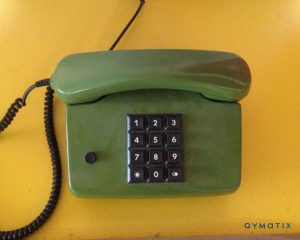Will sales jobs still exist in fifty years from now? Will robots take over all sales jobs? How will artificial intelligence redefine sales management? What long-term influence does digitisation have on B2B sales?
To discuss the future of sales, let’s first present how companies made Business-to-Business sales 50 years ago and how it works today. Let’s then peep inside the crystal ball to see what sales (and marketing) can look like in the future.
Sales 50 years ago – How many typewriters to visit one customer?
The communication tools that became so self-evident in sales today did not exist 50 years ago: smartphone (circa 1994), email (crazy eighties), and the internet. The World Wide Web, born in 1989, connects sales representatives (well, everyone) with people on the other end of the world within seconds.
Believe it or not, offices existed without personal computers (say 1972). To communicate with their customers, salespeople had to rely on the phone and the post office.

Sales managers had to type on a typewriter (1870 – 1980 (?)) or get someone to type for them. If you were born after 1980, you might not be familiar with this sinister, fearful yet loved device. Brevity and accuracy were a must: you better rewrote the page if you had more than three mistakes.
Key Account Managers had to prepare a visit to a potential client thoroughly. She – well, mainly “he” back then – did not have the help of Google to research the customer addresses or its business. Instead, salespeople had to go through printed books that listed customers in different industries. A quick review of the company wasn’t done quickly, either. The information found in these industry books could easily be outdated.
Visiting sales associates had nothing but a printed map. No GPS, no Google that helped you find the fastest route. If there was a traffic jam, it was in your hands to seek for an alternative way. If you were late, you had to stop on a roadhouse to call the client via coin phone – given you had the coins.
When finally at the customer’s office, sales representatives used overhead projectors to present their products and services – page by page, projected from old transparent slides into a wall. If you had forgotten some information, there was no possibility to check the internet or send information quickly via an electronic mail.

Think of doing customer analytics those days: collecting information from different departments, summarising it by hand and finally typing everything down. When everything had been put together on paper, analytics could still be a few days away. At that time, the offices had long lines full of cabinets with customer files, from which sales managers had to gather contracts, orders, and all necessary information about their customers.
Regarding the personal contact with the buyer, every step required longer. There was usually no direct extension to the contact person in the target company. The corporate office usually got all calls, and then put the call manually through. Didn’t you know the intern? No problem! “How do you spell that name again”?
Knowing your competitors was mainly done anecdotally or via trade shows. On the plus side, your competitors also lacked intelligence about your business.
Sales today – Digitalization drives sales forward – faster.
Today, with the use of smartphones, tablet PCs, desktops, the internet, email, and platforms as Google, the work of a salesman became a lot easier. Sales and marketing have more than one small difference, compare with five decades ago.
Key Account Managers can now call clients in seconds – even to meet them virtually thanks to video and webinars. Meetings face to face are becoming a rare commodity. Social networks such as Xing and LinkedIn facilitate searching for the right contact in a target company and allow to get to know the person (and his or her interest) before an individual connection – provided the company permits the usage of social networks, and the information can be accessed.
However, in some German organisations, there are still obstacles: social networks are not be allowed universally due to privacy or time-wasting concerns. Also, not every company is open to the concept of “Bring your own device”. This barrier forces salespeople to carry two different mobile phones – one for their private conversations, one for their job.
Monitoring the activities of your competitors as well as researching prospects is easy and quick: you “google” them. You don’t only find the companies web page on the internet, you also sometimes find reviews by their past clients and employees. Everyone can see and review another company. Today, nobody signs a contract without proper research about a potential supplier. Thanks to content marketing strategies, there is enough information available that addresses any customers’ need and supports him on her “journey”.
Should a sales representative present her products or services to customers, PowerPoint or Keynote come to the rescue – programs that allow anyone to update and edit information quickly. If you forgot to bring to any important material your meeting, you probably have direct access to it via Cloud and can show it to the customer from there.
When it comes to sales analytics, most B2B sales associates are still addicted to Excel. While it is a considerable improvement to doing all the work on paper, it is still time-consuming and error-prone.
Any swift question such as: “with which customers did we make the highest margin in the last six months?” or “do you have a forecast of customers at risk of churning?” can still rouse panic in the most prepared sales managers. Don’t you wish you could have answers on one click here? Some companies are already applying customer churn prediction software to tackle this problem.
Digitalization drives sales forward – faster.
The Future of Sales in 50 Years Is Artificial Intelligence.
Like most disruptions, digital sales are getting off to a shaky start. Nevertheless, what is sales and marketing today if not a collection of digital customer activities?
Big data, social selling, artificial intelligence and – it is quite easy to get lost in the jungle of tools, concepts and solutions.
The necessary skills of exceptional B2B salesperson will remain, but the conditions are changing rapidly.
Executives are taking their time to trust the algorithms and use them to their advantage.
Fifty years on, digital sales will be highly profitable. It will be as much of an evolution as of revolution. Just consider where digital retail is today. For example, with a five-year average return on investment of 17 % (2016 – 2021), Amazon almost triple traditional discount and department stores average of 6.5 %.
50 years from now, the sales trends that we are discussing today will become part of our daily routine: artificial intelligence, predictive analytics, social selling, big data, augmented reality, etc. – today’s buzzwords will become an essential part of everyone’s life. ChatGPT is just the start.
Nobody will be discussing “Bring Your Own Device” policies. This argument became obsolete when Apple bought Microsoft at the end of 2035. However, in 2068, salespeople will not be using a smartphone at all. They will wear glasses that deliver the appropriate data in the right context just in front of their eyes.
An in-person meeting (or we got to call them: “non-virtual interaction”) will only take place when it is necessary. During a sales trip, the salesman doesn’t have to worry about the fastest route to the customer: a self-flying drone takes care about flight jams and optimises the route whenever facing any obstacle.
The time-drone counts as working time. Augmented reality glasses update the salesperson with the latest information on the industry and the customer. Once presenting in front of the customer, these glasses supply the data required to close the deal. Such devices can listen to the whole conversation. They understand the speech being said and give salespeople the most useful suggestions.
Due to energy optimisation, we will avoid all customer visits unless otherwise necessary for a human co-creation. Thanks to Virtual Reality, every in-person meeting feels like sitting in the same room anyway. We will be able to experience handshakes, facial expressions, gestures, and sounds through virtual reality.
In 50 years there will be probably no offices in the way we’re used to them today. Most professionals will be able to work from anywhere: a self-flying drone, a shared farm or planet Mars. Physically sharing an ordinary working office stopped being trendy in 2025.
Since creative jobs are on the rise, working from an unusual place pays off: a beach, a mountain or a galaxy far away. Creativity is a skill highly in demand.
Simple tasks will be replaced by robots – thanks to a rapid executed digital transformation. Corporations will still employ unreliable humans for more complex tasks: evaluate, proof and take un-informed non-logical decisions. Artificial Intelligence Software will transmit automated sales reports to interactive devices.
Simple communication between customer and salespeople is taken care by chatbots able to schedule calls and meetings. To confirm them is obsolete, bots possess every scheduling information they need – both from the customer and the supplier. Only complex pricing discussions, together with other relevant emotional tasks, are left to humans. However, with background information from Qymatix and real-time updates from international markets on AR-glasses, sales managers will be well prepared for even the most demanding sales conversations.
What type of B2B sales will still exist in 50 years? – Conclusion
The world has seen massive changes in the last five decades. This trend will not stop but accelerate. All professional fields will be very different in 50 years. Sales and Marketing are no exception.
During the sixties, offices worked without – nowadays ubiquitous – personal computers. Before smartphones and emails, salespeople used the good old phone and the post office. It was all different back then.
Today, mobile-first, e-commerce, big data, predictive sales analytics, among others are commonplace. Emails even look old and out-of-fashion thanks to social selling. B2B buyers have changed their behaviour, and the digitisation of sales is the right answer.
50 years from now the world of sales will be radically different. Artificial Intelligence applications will take over most of the repetitive tasks of sales, not excluding: customer communication, sales planning, reporting, and controlling. Salespeople will mainly perform sophisticated, creative and critical emotional jobs.
CONTACT US TODAY FOR A CALL
Further Read:
Darrell K. Rigby (2011) The Future of Shopping – Harvard Business Review (Auf Englisch)
